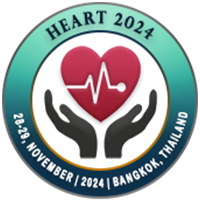
Jes. S. Lindholt
Odense University Hospital, DenmarkTitle: User-defined outcomes of the Danish Cardiovascular Screening (DANCAVAS) trial: A population-based, randomised controlled trial
Abstract
Objective: To assess whether a CT-based cardio-vascular screening examination is requested by elderly men and reduce a user-defined outcome.
Design: A randomised cardiovascular screening and intervention trial started in Sep 2014.
Setting: Population-based, multicentre, parallel group.
Participants: All men 65 to 74 years of age residing in specific areas of Denmark were randomised (1:2) to invitation-to-screening (16,736 men, of which 10,471 underwent screening) or usual-care (29,790 men).
Intervention: The examination included a non-contrast CT scan (to assess the coronary artery calcium score and aortic aneurysms), and ankle–brachial blood-pressure measurements (to detect peripheral artery disease). Positive findings prompted preventive treatment with atorvastatin, aspirin. The usual-care group remained unaware of the trial and the assignments.
Main outcome: The user-defined outcome was determined through a survey sent in January 2023 to a random sample of 9,095 men from the target group, with a 68.0% response rate (6,182 respondents). Safety outcomes included severe bleeding and mortality within 30 days after cardiovascular surgery. Analyses were performed on an intention-to-screen basis.
Results: Prevention of stroke and myocardial infarction was the primary motivation for participating in the screening examination. After a median follow-up of 6.4 years, 1,800 men (10.8%) in the invited-to-screening group and 3,420 (11.5%) in the usual-care group experienced an event (hazard ratio (HR), 0.93 (95% CI, 0.88 to 0.98; p=0.010); number needed to invite, 148 (95% CI, 80 to 986)). A total of 324 men (1.9%) in the invited-to-screening group and 491 (1.7%) in the usual-care 24 group had an intracranial bleeding (HR, 1.17; 95% CI, 1.02 to 1.35; p=0.029). No differences were found in mortality after cardiovascular surgery.
Conclusion: This comprehensive population-based cardiovascular screening and intervention program may reduce the user-defined outcome, stroke and myocardial infarction, but entail a small increased risk of intracranial bleeding.
Trial Registration: ISRCTN Registry number, ISRCTN12157806.
Biography
Jes S. Lindholt graduated from medical school, 26 years old, and was trianed as a vasular surgery at Viborg Hospital, Aarhus University Hospital Skejby, and Copenhagen University Hospital Rigshospitalet, and completed his Ph.D. at the age of 35 years and his doctoral thesis at the age of 47 - both from Århus University, Denmark. Today he is a professor and leading consultant of vascular surgery at the University Hospital of Odense, University of Southern Denmark, Denmark, and the head of Cardiovascular Centre of Excellence in the Region of Southern Denmark. He has been the PI of three large randomized cardiovascular screening trials (the Viborg AAA screening trial, VIVA and DANCAVAS), randomizing a total of 140,000 people, and currently coordinating two larger research consortiums regarding home-based personalized cardiovascular risk estimation and preventive potential (PREPARE - SDU) and development of a SMART dialysis graft (TeleGraft - SDU). At Scopus, he has 351 documents with 17,091 citations, and a field-weighted citation impact: 5.93.

